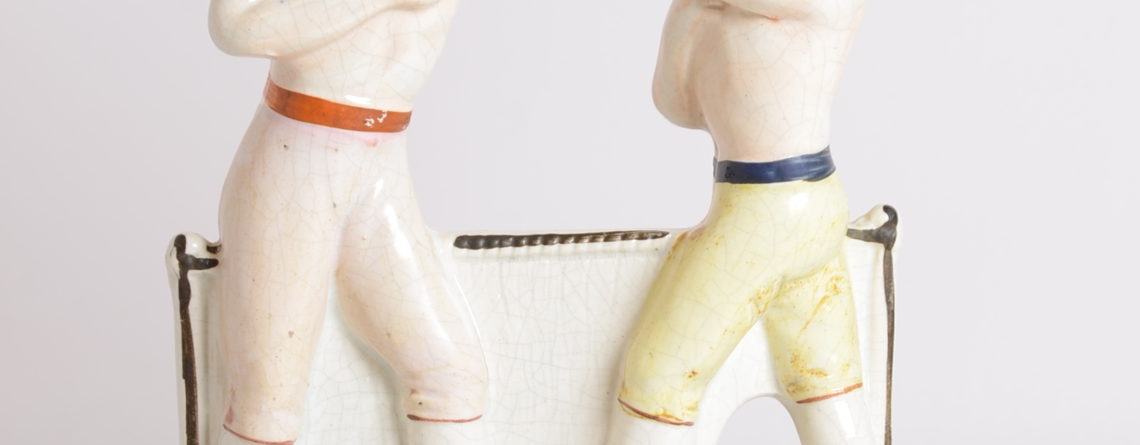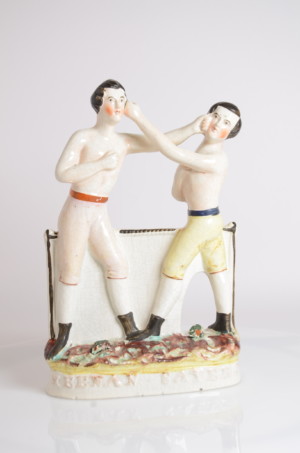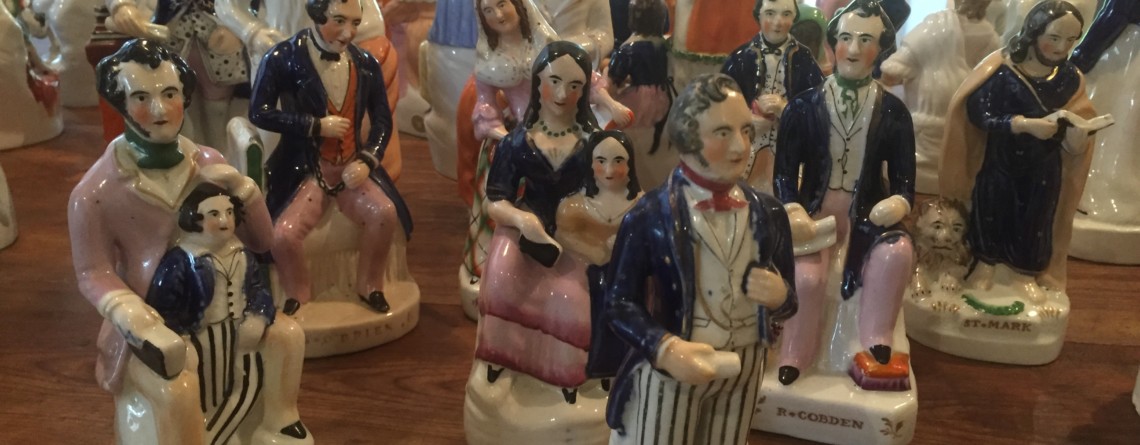The Italian Boy (Carlo Ferrari) A Mystery Figure Solved
Crime figures, criminals, their accomplices and victims are limited when it comes to collecting Staffordshire figures, in which I include both pre-Victorian and Victorian examples. In recent times, this collecting genre has become increasingly desirable and difficult to locate and secure for one’s personal collection.
I could name a few pre-Victorian examples for those that are unfamiliar with what has been discovered so far. The ‘Red Barn’ figures associated with the murder by William Corder, his victim, Maria Marten. The ‘Assassination of Jean-Paul Marat’ by Charlotte Corday. We also have ‘Jack Sheppard’ who inspired that 20th century hit song Mack the Knife.
As for Victorian examples, we have a few more. ‘William Palmer’ the Rugeley poisoner and his ‘House’. ‘James B Rush’ who was tried mainly on the evidence of ‘Emily Sandford’. ‘Frederick Manning’ and his wife ‘Maria Manning’ for the murder of Patrick O’Conner. Then there are the criminals, ‘William Smith O’Brien’ and its pair, his devoted wife Lucy, ‘Mrs O’Brien’. We also have ‘John Brown’ the insurrectionist, and also the Decembrist Colonel Paul ‘Pestel’. Not forgetting a multitude of ‘Robin Hood’, ‘Tom King’ and ‘Dick Turpin’ figures, and of course the hotly debated ‘Smith and Collier’ groups! There are probably some others I have missed out, for which I apologise.
Most command high prices these days and are highly collectable by those among us with a taste for intrigue and the macabre! Few, if any new examples have come to light in the last fifty years with a positive attribution. It would appear they have all been found; to add another to the exclusive list above would be classed as a remarkable discovery, especially in the 21st century, one that I hope would be scrutinised rigorously by those serious Staffordshire figure scholars and collectors among us.
So, on this note I am going to stick my neck out and dare to put forward an old contender with a newly found attribution, one that I believe reveals indisputable and fresh evidence, new discovery material that, I hope, will add one more figure for the crime figure collectors to look out for. This attribution is based on evidence recently gathered and brought together by myself, parts of a jigsaw puzzle, the pieces of which have been discovered by several individuals over many years and finally pieced together by curiosity, the determination to know, a little bit of luck, plenty of serendipity, and most importantly, a lifelong love of Staffordshire figure collecting!
Figure 1 – A rare subjectFor those not familiar with it, figure 1 has long been the object of many discerning collector’s curiosity. An innocent young boy is seated on what looks to be a market crate. He is wearing a smart outfit, bowler type hat, shirt, necktie, waistcoat, jacket and trousers. On his lap he is cradling a caged rodent, is it a rat or is it a mouse? The mammal is curiously and very finely painted behind the bars of a cage, detailed meticulously by a skilful decorator, the likes of which I cannot recall seeing painted so well on any other Staffordshire figure. The potters have gone to great lengths and care to emphasise the importance of the caged animal by detailing it so; this leaves us in no doubt about its significance in the story they are trying to portray.
Some may doubt my dating of this well coloured and unsigned example, which I place to the early 1830’s. Please bear with me and read my findings before dismissing this at the first hurdle. One might associate the quality of this piece with the Lloyds of Shelton or more probably an early Dudson figure, perhaps?
But how could this sweet little innocent boy possibly fall into the ‘macabre’ category, I hear you ask?
I have seen four or five examples of this figure over the last 35 years. One appeared in Antique Collecting magazine, October 1989 edition, written by Delia Napier. The article focused mainly on John & Rebecca Lloyd of Shelton figures. The only other published illustration I have managed to find can be found in the book A Potted History (Henry Willett’s Ceramic Chronicle of Britain) by Stella Beddoe, page 311 and figure 1620. The figure is part of the wonderful Willett Collection on show at the Brighton Museum & Art Gallery here in the U.K. The collection was formed in the latter part of the 19th century, a must-see museum display for any serious lover of English pottery. Stella also dates this figure to c1830 and gives the illustration in her book the title ‘Italian?’ a name I assume which has been handed down with the figure since it was first acquired and added to the collection pre-c1900.
No further details or explanation of the piece to my knowledge exists. It would be nice to think that at the time of its purchase by Mr Willet, he knew a little bit about who the chap was, for that name and date to have been added to the inventory and subsequently handed down. The intervening years appear to have eroded whatever other knowledge was known of it from the public domain. Nevertheless, this first clue is very intriguing and a good start, all that is required to fan the flames of my curiosity into finding out the identity of this beautiful little figure.
So, what is an ‘Italian Boy’ and what is the significance of his apparent innocence and his caged animal?Italian immigrants have been travelling to parts of Great Britain and London for hundreds of years. One of the latest waves at the time this figure was manufactured, I am led to believe, came as a result of the hardships brought on after the Napoleonic Wars. Many ‘Italian Boys’ would do well earning a living on the streets because of their good looks and innocent faces, performing several entertaining pursuits as itinerant musicians, some with exotic animals such as monkeys doing tricks, displaying tortoises, and exhibiting trained mice. Others would be image sellers, touting plaster of Paris figures of popular celebrities and politicians aloft on trays as seen in illustration 1. Some may even have sold our very own Staffordshire figures that we collect today!
Illustration 1 – Could this be Staffordshire for sale?
My second stroke of good luck arrived about eight months ago. I was very fortunate to have acquired a similar example, figure 2, slightly different in a number of ways but obviously portraying the same person. The detail of the caged animal is not as refined, but he does wear the same clothes. However, the one main difference is that this figure sits quite clearly on some steps. This figurine I believe may be quite unique, I have never seen another.
Figure 2 – A similar recent find
Some reading this article may be aware of my abilities to find the rare and unusual for my stock at RTS Antiques. I am very lucky to be able to do this work for a living and count myself fortunate to enjoy immensely the processes involved; the constant searching and researching is in my opinion, true job satisfaction. I must point out it is not as easy as it seems as it takes many hours of dedicated looking to find these gems. Some, I sense, are not as fortunate as I to be able to dedicate so much time and be so vigilant (or unlike me, have far better things to do with their time!). As the old saying goes, ‘The early bird catches the worm’. Many though, I believe, are quite happy and content to let seasoned dedicated dealers do the hard work, trusting them to find the very best examples out there for their consideration. But forgive me, I seem to have gotten off my subject...
I bought the little beauty from a small obscure auction house here in the U.K. I find they can be one of the best places to buy from, if you are prepared to put in the hours of traveling and searching, that is. Found in a dirty old dusty box in the back of beyond, I was delighted to find along with the figure some other bits and bobs, one of which was a curious brown envelope (serendipity) containing a couple of letters and several printed pages showing illustrations from a book. The letters transpired to be the correspondence between the owner of the figure and a Bonhams auction house specialist, and they dated back to January 2007. I later learned that the two copied pages came from a book that was published back in 2004, the author, Sarah Wise, the book title, The Italian Boy, Murder & Grave Robbery in 1830’s London, see illustration 2. I found a copy online and waited for it to arrive in the post!
Illustration 2 – Cover of book, portrait of Carlo with caged mice by artist John Hayes, 1832
As I read the pages, a terrible tale began to emerge of the grisly early 19th century practice of grave robbing. This disgusting practice was performed for a handsome profit by those who had lowered themselves to carry out this illegal work. It was funded by numerous hospitals and medical institutions of the day, all willing to turn a blind eye, desperate for bodies to practice this emerging science on.
St Bartholomew's and Guys were just a few that took these cadavers in. Surgeons and medical students would then practise anatomy on the dead corpses. Impoverished London low lives and petty criminals capitalised on this unholy occupation earning upwards of 20 guineas a body, which in turn gained them the unwholesome job titles of ‘Resurrection Men’ and ‘Resurrectionists’ to name a couple!
The author Sarah Wise summarises:
In the 1830s, town planners condemned the City of London as a metropolitan abomination. Smithfield meat market was choked with animal fat and foam; Pissing Alley was ankle-deep in excrement. The sale of livestock in the city centre must have been an extraordinary sight for a newcomer. Carlo Ferrari, a teenage migrant from rural Italy, was an inhabitant of the area. He scraped a living by exhibiting caged white mice to Smithfield passers-by. By associating with card sharps and other chancers, he had exposed himself to danger. On the afternoon of 3 November 1831, the boy was killed by "resurrection men", or body-snatchers, who then sold his corpse to anatomists.
Illustration 3 – A detailed etching (Image: Wellcombe Trust/Creative Commons)
Here we have a few contemporary illustrations published at the time of his murder, artist interpretations of Carlo Ferrari. The first etching, illustration 3, shows the Italian boy standing, holding one of his pets in both hands. The second, illustration 4, shows him seated at the top of some steps, clothed in cap, shirt, waistcoat, jacket and trousers. He has a cage of white mice on his lap, a sweet innocent smile on his face. Like many other ‘Italian Boys’ he was forced to emigrate because of hardships in his own country brought on after the Napoleonic Wars. He would have been one of many similar boys who hawked images, performed tricks with mice and other exotic animals or played street music for passers-by to be entertained, all in the hope of earning a few pennies. These illustrations are just a few of the many images of Carlo published as broadsheets (cheaply printed single news sheets sold on street corners by independent printers and journalists) at the time of the trial in 1831. Both illustration 4 and illustration 5, I believe, were the sources the potters used as the inspiration for the two figures so far recorded.
Illustration 4 – Possible source image for Staffordshire potters
Illustration 5 – Another image for the Staffordshire potters to draw from
Sarah Wise continues:
Over 200 body-snatchers were estimated to operate in London at this time. Anatomy was still in its infancy as a science and surgeons where eager to practise their skills. Smithfield's proximity to a hospital - St Bartholomew's - meant it was ideally situated for the traffic in human corpses. Most resurrectionists of course did not murder but instead disinterred fresh bodies from graveyards. Three men, Bishop, May and Williams, (illustration 6) however, stood accused of abducting and slaughtering Carlo, and their crime outraged all London.
Illustration 6 – The three men accused of the crime
The trial that resulted from this terrible crime gave detailed eyewitness accounts of sightings of Carlo Ferrari days before his disappearance. John Bishop and Thomas Williams were found guilty of murder and hanged in front of a crowd of 30,000 at Newgate on 5 December 1831. They became known as the ‘London Burkers’, as the crimes they committed mirrored the earlier convictions of William Burke and William Hare in Edinburgh Scotland 1828. Illustration 7 is a broadsheet of the trial, and illustration 8 is a close up of a page taken from a newspaper article about the trial that appeared in The Sunday Times of London, December 1831.
Illustration 7 – Broadsheet of the trial
Illustration 8 – From the Sunday Times of London, Dec. 1831
In a final twist, Sarah concludes:
Yet the truth behind their deed was muddied by newspapers and witnesses. From the trial documents it seems the trio had not snatched an Italian street boy at all but delivered to a hospital the body of a Lincolnshire drover who worked the cattle pens off Smithfield's Chick Lane. Why the elaboration? In London's febrile imagination, the slaying of a pretty, olive-cheeked Italian made for a more satisfyingly brutal story; nobody cared about a Lincolnshire boy.
James May was exonerated of murder, his crime being only a member of the gang who would help with delivery; it was found he had no involvement in any of the murders. It would seem he was more fortunate or unfortunate as the case may be. He was sentenced to penal transportation to Van Diemen’s Land but died a few years later. He received a two-year sentence to Port Arthur for insubordination on board the penal transport vessel and died at the settlement in 1834.So, there we have it, I believe based on this evidence the two figures of the seated boy holding the caged mouse on his lap should now be recognised as none other than portrait figures of the murdered Italian Boy, Carlo Ferrari, a story later found to have been sensationalized by the press during the trial in December 1831 and picked up on by our Staffordshire potters at the time, who then went on to create these two splendid examples. In reality the confessions given by Bishop and Williams the day before their execution revealed, in their own words, they had murdered not one but several unfortunate souls. They denied ever killing the Italian boy.................... but somebody did, he and his caged mice were never seen again!!
If you want to read the story in more detail, please get a copy of the book! We are always interested in purchasing rare and unusual original Staffordshire figures like these, if you have a similar example that you are wishing to sell, please get in touch.










